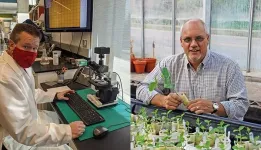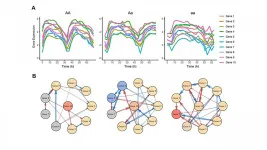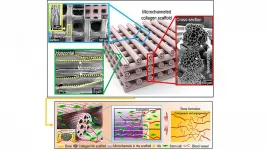A calculator that predicts risk of lung cancer underperforms in diverse populations
Research finds that a commonly used risk-prediction model for lung cancer does not accurately identify high-risk Black patients who could benefit from early screening
2021-05-04
(Press-News.org) PHILADELPHIA - Lung cancer is the third most common cancer in the U.S. and the leading cause of cancer death, with about 80% of the total 154,000 deaths recorded each year caused by cigarette smoking. Black men are more likely to develop and die from lung cancer than persons of any other racial or ethnic group, pointing to severe racial disparities. For example, research has shown that Black patients are less likely to receive early diagnosis and life-saving treatments like surgery. Now researchers at Jefferson have found that a commonly used risk prediction model does not accurately identify high-risk Black patients who could gain life-saving benefit from early screening, and paves the way for improving screenings and guidelines. The research was published in JAMA Network Open on April 6.
"Black individuals develop lung cancer at younger ages and with less intense smoking histories compared to white individuals," explains Julia Barta, MD, Assistant Professor of Medicine in the Division of Pulmonary and Critical Care Medicine at Thomas Jefferson University, and researcher at the Jane and Leonard Korman Respiratory Institute. "Updated guidelines now recommend screening eligible patients beginning at age 50, but could still potentially exclude higher-risk Black patients. We are interested in finding methods that could help identify at-risk patients who are under-screened."
Screening for lung cancer is an annual CT scan to detect the presence of lung cancer in otherwise healthy people with a high risk of lung cancer. Current guidelines do not require a risk score for screening eligibility, but some researchers think that risk models could improve care. Risk prediction models are mathematical equations that take into account risk factors like smoking history and age to produce a risk score, which indicates the risk for developing lung cancer. Existing risk prediction models are derived from screening data that only include 5% or fewer African American individuals.
"What makes our study unique is that our screening cohort included more than 40% Black individuals," says senior author Dr. Barta, a member of Sidney Kimmel Cancer Center - Jefferson Health. "To our knowledge, our study is the first to examine lung cancer risk in a diverse screening program and aims to strengthen the argument for more inclusive guidelines for screening eligibility."
The most well-validated model used in screening research is the Prostate, Lung, Colorectal and Ovarian Cancer Screening Trial modified logistic regression model (PLCOm2012). "It uses 10-12 risk factors that include age, race, smoking history, as well as some socioeconomic factors like education to calculate a risk score," says Christine Shusted, MPH, first author of the study and research data analyst for Jefferson's Lung Cancer Screening Program through the Korman Respiratory Institute at Thomas Jefferson University. "The higher the score, the higher the risk of developing lung cancer. We wanted to see how well this model identifies patients with the highest risk of lung cancer in this diverse patient population."
The researchers conducted a cross-sectional, retrospective study in 1,276 Black and white patients (mean age, 64.25 years; 42.7% Black; 59.3% women) who enrolled in the Jefferson Lung Cancer Screening Program between January 2018 and September 2020. From this screening cohort, lung cancer was detected in 32 patients, 44% of whom were Black - these patients formed the cancer cohort. The researchers then calculated risk scores using the PLCOm2012 model. In the screening cohort, more Black patients than white patients were in high-risk groups, indicating that Black patients in this cohort had a higher risk of developing lung cancer.
As anticipated, white patients with screen-detected lung cancer generally had high lung cancer risk scores. "Among Black patients, we would have expected to see a similar trend," explains Dr. Barta. "However, we saw that despite having a lung cancer diagnosis through screening, Black patients were actually defined as lower risk. This indicates that the model is not accurately predicting risk of lung cancer in Black patients."
"These findings allowed us to identify weaknesses in this model for risk calculation for lung cancer," explains Shusted. "It indicates that we need to not only expand criteria for lung cancer screening so that more diverse populations are included, but that these prediction models need to include factors, like environmental contributors, access to health care, and other social determinants of health."
The researchers hope to continue building on these findings, with the ultimate goal of defining comprehensive risk factors and improving lung cancer screening uptake and adherence especially among vulnerable populations.
"This work is an important step to reducing disparities in the screening and early detection of lung cancer, and making sure we can trust our models to predict those individuals at the highest risk," says Dr. Barta.
INFORMATION:
This work was supported in part by the Bristol Myers-Squibb Foundation's Specialty Care for Vulnerable Populations initiative. Dr. Barta reported receiving grants from the Genentech Health Equity Innovations Fund and the Prevent Cancer Foundation outside the submitted work. The authors report no other conflicts of interest.
Article Reference: Christine Shusted, Nathaniel Evans, Hee-Soon Juon, Gregory Kane, Julie Barta, "Association of Race With Lung Cancer Risk Among Adults Undergoing Lung Cancer Screening," JAMA Network Open, DOI: 10.1001/jamanetworkopen.2021.4509, 2021
Media Contact: Karuna Meda, 267-624-4792, karuna.meda@jefferson.edu
ELSE PRESS RELEASES FROM THIS DATE:
2021-05-04
A new study, published in JCI Insight, looks at how Brd4, a regulator of the innate immune response, influences diet-induced obesity. The researchers believe that Brd4 could be used as a target for obesity and insulin resistance.
Approximately one-third of the adults and one in five children in the U.S. have obesity problems. Unfortunately, the condition is also associated with the development of other diseases including diabetes, cardiovascular disorders, and cancer. "One of the biggest challenges we face is trying to understand how people develop obesity. If we can understand that, we can develop solutions for treating or preventing these diseases," said Lin-Feng Chen (MME), a professor of biochemistry.
The researchers investigated the role of the ...
2021-05-04
The soybean cyst nematode (SCN) is the most damaging pathogen of soybean in the United States and Canada and it is spreading rapidly, according to information compiled by Gregory Tylka and Christopher Marett, nematologists at Iowa State University. SCN was first found in the United States in 1954 and most recent estimates show that SCN results in $1.5 billion in annual yield losses.
"The continuing spread of SCN is alarming, but not surprising," said Tylka. "Anything that moves soil can move the nematode, including wind, water, and farm machinery." ...
2021-05-04
Educating athletes, parents and coaches about concussion treatment and prevention has been a priority during the last decade, but are the intended audiences hearing the message?
New research from the University of Michigan found that 1 in 4 adolescents self-reported at least one concussion in 2020, up from about 20% in 2016. During that same time period, youth who reported one concussion rose from roughly 14% to 18%, and those who reported at least two concussions increased from about 6% to 7%.
"Self-reported concussions could be increasing given that both children and parents have greater ...
2021-05-04
Researchers at AMBER, the SFI Centre for Advanced Materials and BioEngineering Research, and from Trinity's School of Physics, have developed next-generation, graphene-based sensing technology using their innovative G-Putty material.
The team's printed sensors are 50 times more sensitive than the industry standard and outperform other comparable nano-enabled sensors in an important metric seen as a game-changer in the industry: flexibility.
Maximising sensitivity and flexibility without reducing performance makes the teams' technology an ideal candidate for the emerging areas ...
2021-05-04
A hot topic symposia session during the Pediatric Academic Societies (PAS) 2021 Virtual Meeting will address the persistent controversies and questions in preterm infant nutrition.
After six years of interdisciplinary expert discussion and critical evidence review, the 2014 vision to develop evidence-informed guidance for the nutritional care of preterm infants has come to fruition. The Eunice Kennedy Shriver National Institute of Child Health and Human Development (NICHD) and the Academy of Nutrition and Dietetics (AND) initiated this multiphase process involving expert physician, dietitian, and pharmacology scientists.
The first phase, Pre-B, addressed the existing evidence and research ...
2021-05-04
WASHINGTON, May 4, 2021 -- How body clocks work could lead to science that can turn an early bird into a night owl or vice versa as well as other advances, like helping crops grow all year long.
In Applied Physics Reviews, by AIP Publishing, scientists at Penn State report on their work advancing knowledge about circadian rhythms, the natural process that governs sleep and waking patterns in humans, animals, and plants.
Researchers have identified a set of genes, called clock genes, that control these rhythms. But a more complicated network of genes than previously known appears related to circadian rhythms. More fully ...
2021-05-04
WASHINGTON, May 4, 2021 -- If a respiratory droplet from a person infected with COVID-19 lands on a surface, it becomes a possible source of disease spread. This is known as the fomite route of disease spread, in which the aqueous phase of the respiratory droplet serves as a medium for virus survival.
The lifespan of the respiratory droplet dictates how likely a surface is to spread a virus. While 99.9% of the droplet's liquid content evaporates within a few minutes, a residual thin film that allows the virus to survive can be left behind.
This begs ...
2021-05-04
What The Study Did: This survey study estimated change in the percentage of adolescents in the United States who reported at least one diagnosed concussion during their lifetime.
Authors: Phil Veliz, Ph.D., of the University of Michigan in Ann Arbor, is the corresponding author.
To access the embargoed study: Visit our For The Media website at this link https://media.jamanetwork.com/
(doi:10.1001/jama.2021.1538)
Editor's Note: The article includes funding/support disclosures. Please see the article for additional information, including other authors, author contributions and affiliations, ...
2021-05-04
During our waking hours, the brain is receiving a near-constant influx of sensory signals of various strengths. For decades, scientists have wondered why some signals rise to the light of conscious awareness while other signals of a similar strength remain in the dark shadows of unconsciousness. What controls the gate that separates the shadows and the light?
In a new study from the Department of Anesthesiology and Center for Consciousness Science at Michigan Medicine, researchers identify a key area in the cortex that appears to be the gate of conscious awareness.
"Information processing in the brain ...
2021-05-04
WASHINGTON, May 4, 2021 -- Spinal fusion is frequently performed to restore spinal stability in patients with spinal diseases, such as spinal stenosis, vertebral fractures, progressive deformities, and instability. In the past two decades, there has been marked increase in the number of people over 65 years in age who have needed spinal fusion surgery.
While autogenous bone grafts have long been considered the reference standard for spinal fusion, painful pseudoarthrosis remains a leading cause of poor clinical outcomes. Many researchers have consequently focused on ...
LAST 30 PRESS RELEASES:
[Press-News.org] A calculator that predicts risk of lung cancer underperforms in diverse populations
Research finds that a commonly used risk-prediction model for lung cancer does not accurately identify high-risk Black patients who could benefit from early screening





